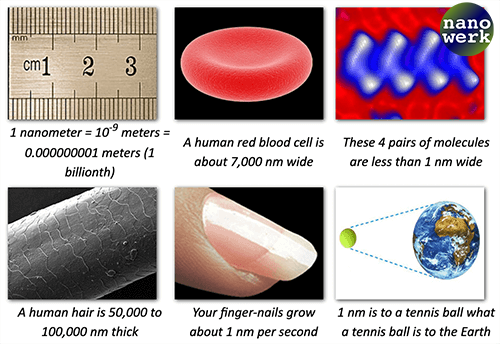Exploring the Nanoscale
Definition: Nanoscale refers to dimensions and tolerances in the range of 1 to 100 nanometers (nm). A nanometer is one-billionth of a meter, a scale so small that it encompasses the atomic and molecular levels. At this scale, materials exhibit unique physical, chemical, and biological properties that differ significantly from those seen in bulk materials. These unique properties are the cornerstone of nanotechnology, a field dedicated to the design, synthesis, and application of materials whose structures are precisely controlled at the nanometer scale.

Properties and Phenomena at the Nanoscale
Materials at the nanoscale behave differently from their larger counterparts due to the increased surface area to volume ratio and the dominance of quantum size effects. For example, quantum dots, tiny semiconductor particles a few nanometers in size, exhibit quantum mechanical properties that allow them to emit light at different wavelengths based on their size. This quantum confinement effect enables applications ranging from medical imaging to quantum computing.
Applications of Nanoscale Technologies
Nanotechnology has paved the way for revolutionary applications across diverse fields. Here are a couple of examples illustrating the impact of nanoscale materials:
Medical Diagnostics and Therapeutics: Gold nanoparticles, utilized for their exceptional optical properties at the nanoscale, enhance the sensitivity and specificity of rapid diagnostic tests. Their ability to absorb and scatter light makes them ideal for bioimaging, enabling researchers to track the dynamics of biological processes in real-time.
Energy Storage and Conversion: The nanoscale structure of certain materials can significantly improve the performance of batteries and solar cells. For instance, nanostructured silicon offers increased charge capacity and efficiency in lithium-ion batteries, addressing the demand for high-performance energy storage solutions.
Environmental Remediation: Nanoscale materials offer promising solutions for environmental cleanup and protection. For instance, nanoscale zero-valent iron (nZVI) is used for the remediation of groundwater contaminated with heavy metals and organic compounds. These nanoparticles can effectively adsorb and reduce contaminants, converting them into less harmful substances. Similarly, nanoporous materials are being developed for carbon capture and storage, aiming to reduce greenhouse gas emissions from industrial sources.
Electronics and Computing: Nanotechnology plays a critical role in the evolution of electronics and computing, enabling the production of faster, smaller, and more efficient devices. Carbon nanotubes and graphene are used in transistors, memory chips, and displays, offering superior electrical conductivity and strength. Quantum dots, with their size-tunable optical properties, are employed in high-resolution displays and light-emitting diodes (LEDs), enhancing color purity and energy efficiency.
Textiles: The integration of nanomaterials into textiles has led to the creation of fabrics with extraordinary properties. Nanosilver and nanocopper impart antimicrobial properties to clothing, making them ideal for medical and sportswear applications. Nanocoatings on fabrics can provide water-repellency, stain resistance, and self-cleaning capabilities, extending the functionality and durability of textiles.
Agriculture and Food Packaging: Nanotechnology offers innovative solutions for agriculture, enhancing crop protection, nutrient delivery, and sustainable farming practices. Nanosensors can monitor soil conditions and crop health in real-time, enabling precise agriculture. In food packaging, nanocomposite materials can improve mechanical strength, barrier properties, and shelf life of food products. Silver nanoparticles incorporated into packaging materials provide antimicrobial effects, reducing food spoilage and waste.
Water Treatment and Filtration: Nanotechnology plays a pivotal role in addressing global water scarcity and contamination issues. Nanofiltration membranes can remove pollutants, pathogens, and salts from water more efficiently than traditional filtration technologies. Photocatalytic nanomaterials like titanium dioxide nanoparticles can degrade organic pollutants in water under sunlight, offering a green approach to water purification.
These examples illustrate the versatility and potential of nanotechnology across various industries. By harnessing the unique properties of nanoscale materials, scientists and engineers are developing solutions that address some of the most pressing challenges facing society today, from environmental sustainability to healthcare and beyond.
Nanoscale Measurement and Manipulation
Advancements in microscopy and other analytical techniques have enabled scientists to observe, measure, and manipulate materials at the nanoscale. Techniques such as atomic force microscopy (AFM) and scanning tunneling microscopy (STM) provide detailed surface images and allow for the manipulation of individual atoms. These tools are essential for the development and characterization of nanomaterials and nanodevices.
Ethical Considerations and Future Perspectives
As nanotechnology continues to evolve, it brings along ethical considerations regarding environmental impact, health, and safety. Responsible research and development, guided by ethical principles and regulatory frameworks, are crucial to harness the benefits of nanoscale technologies while mitigating potential risks.
